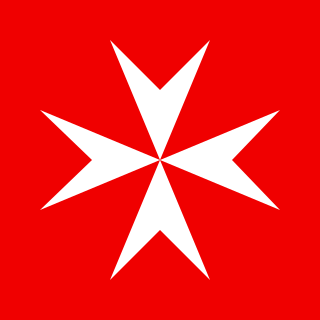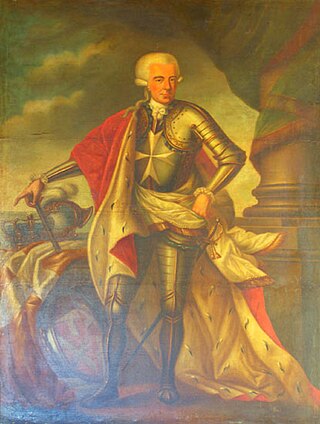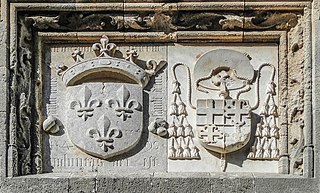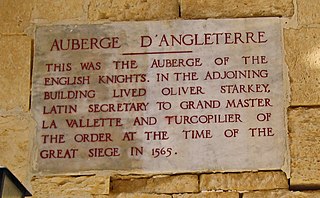A bailiff (French : bailli, French pronunciation: [baji] ) was a high official in the Knights Hospitaller who directed one of its bailiwicks abroad or one of the national associations ("tongues") at its headquarters.
A bailiff (French : bailli, French pronunciation: [baji] ) was a high official in the Knights Hospitaller who directed one of its bailiwicks abroad or one of the national associations ("tongues") at its headquarters.
Bailiff was the rank and title of the head of each of the bailiwicks of the Knights Hospitaller and also of the head, at Rhodes and Malta, of one of the seven, later eight, Langues (or tongues) into which the members of the Knights Hospitaller were grouped once the Order was established on Rhodes and subsequently on Malta. The langues were Auvergne, Aragon (later split into Castile-Portugal and Aragon-Navarre), England, France, Germany, Italy, and Provence.
Despite the seeming link to language, this organization was not strictly aligned with linguistic boundaries, but tended to combine the Order's knights and possessions in several nations or states; the German tongue, for instance, included Scandinavia, Hungary, Poland and Bohemia. Each tongue covered at least one Grand Priory. The Grand Prior and the Chapter, which comprised representatives of all bailiwicks and commandries, administered the individual tongues—including the Order's possessions, its charitable activities (hospitals etc.), parishes incorporated into the Order, and the financial contributions for the defense of Rhodes and later Malta and for the maintenance of the Order's naval forces in the Mediterranean.
At the center, in Rhodes and subsequently Malta, each tongue had its own auberge (hostel) which served as its headquarters and where the members lodged and took their meals. Presiding over the auberge was the "pillar", who by virtue of his office was a Baliff of the Order and, typically, therefore also a member of the Order's Chapter-General representing his tongue. The bailiffs ranked just below the Grand Priors and Priors. They commanded the knights of their tongue at the center, where each tongue was responsible for the maintenance and defense of a specific portion of the fortress defenses and had to man it with sufficient numbers of knights and soldiers.

The Sovereign Military Order of Malta (SMOM), officially the Sovereign Military Hospitaller Order of Saint John of Jerusalem, of Rhodes and of Malta, commonly known as the Order of Malta or Knights of Malta, is a Catholic lay religious order, traditionally of a military, chivalric, and noble nature. Though it possesses no territory, the order is often considered a sovereign entity under international law.

The Order of St John, short for Most Venerable Order of the Hospital of Saint John of Jerusalem and also known as St John International, is a British royal order of chivalry constituted in 1888 by royal charter from Queen Victoria and dedicated to St John the Baptist.

The Bailiwick of Brandenburg of the Chivalric Order of Saint John of the Hospital at Jerusalem, commonly known as the Order of Saint John or the Johanniter Order, is the German Protestant branch of the Knights Hospitaller, the oldest surviving chivalric order, which generally is considered to have been founded at Jerusalem in 1099.

Ferdinand von Hompesch zu Bolheim, O.S.I. was the 71st Grand Master of the Knights Hospitaller, formally the Order of St. John of Jerusalem, by then better known as the Knights of Malta. He was the first German elected to the office. It was under his rule that the Order lost the island of Malta to France, after ruling there since 1530. This effectively marked the end of their sovereignty over an independent state, dating from the time of the Crusades.

The Auberge d'Aragon is an auberge in Valletta, Malta. It was built in 1571 to house knights of the Order of Saint John from the langue of Aragon, Navarre and Catalonia. It is the only surviving auberge in Valletta which retains its original Mannerist design by the architect Girolamo Cassar.
Prior is an ecclesiastical title for a superior in some religious orders. The word is derived from the Latin for "earlier" or "first". Its earlier generic usage referred to any monastic superior. In abbeys, a prior would be lower in rank than the abbey's abbot or abbess.

Manuel Pinto da Fonseca was a Portuguese nobleman, the 68th Grand Master of the Order of Saint John, from 1741 until his death.

Fra' Philippe de Villiers de L'Isle-Adam was a prominent member of the Knights Hospitaller at Rhodes and later Malta. Having risen to the position of Prior of the Langue of Auvergne, he was elected 44th Grand Master of the Order in 1521.

A langue or tongue was an administrative division of the Knights Hospitaller between 1319 and 1798. The term referred to a rough ethno-linguistic division of the geographical distribution of the Order's members and possessions. Each langue was subdivided into Priories or Grand Priories, Bailiwicks and Commanderies. Each langue had an auberge as its headquarters, some of which still survive in Rhodes, Birgu and Valletta.

The Order of Knights of the Hospital of Saint John of Jerusalem, commonly known as the Knights Hospitaller, is a medieval and early modern Catholic military order. It was founded in the Kingdom of Jerusalem in the 12th century and had headquarters there until 1291, thereafter being based in Kolossi Castle in Cyprus (1302–1310), the island of Rhodes (1310–1522), Malta (1530–1798), and Saint Petersburg (1799–1801).

Sir Oliver Starkey (c.1523-83/86), was an English knight who lived in the 16th century. He was the only English knight present at the siege of Malta. It was wrongly assumed that he was buried in the crypt of St. John's Co-Cathedral in Valletta. The tombstone with his name on it contains only a poem written by Oliver Starkey for Grand Master Jean de La Valette. The Poem reads, in translation:'To God, Supreme, Almighty, Sacrosanct. He [La Valette] was the dread of Asia and Libya and once the guardian of Europe, after he had subdued the Turks by means of his Sacred Arms, the first one to lie buried in the grave, here in this propitious city of Valletta which he founded, worthy of eternal honour. Fra. Oliver Starkey, Pro-Turcopolier, wrote [this] poem.'

Auberge de Provence is an auberge in Valletta, Malta. It was built in the sixteenth century to house knights of the Order of Saint John from the langue of Provence. It now houses the National Museum of Archaeology.

Auberge de France refers to two auberges in Valletta, Malta. They were both built in the 16th century to house knights of the Order of Saint John from the langue of France, which induced the entire Kingdom of France except for Auvergne and Provence which were separate langues.

The Auberge de Bavière is a palace in Valletta, Malta. It was built as Palazzo Carneiro in 1696, and it was the residence of Grand Master Marc'Antonio Zondadari in the early 18th century. In 1784, it was converted into the auberge for the Anglo-Bavarian langue of the Order of Saint John, and it remained so until the French occupation of Malta in 1798.

Auberge d'Angleterre is an auberge in Birgu, Malta. It was built in around 1534 to house knights of the Order of Saint John from the langue of England. It now houses a health centre, and it is the best-preserved Hospitaller auberge in Birgu.

The Auberge d'Aragon is an auberge in Birgu, Malta. It was built in the 16th century to house knights of the Order of Saint John from the langue of Aragon, Navarre and Catalonia.

Auberge de France is an auberge in Birgu, Malta. It was built in around 1533 to house knights of the Order of Saint John from the langue of France, which induced the entire Kingdom of France except for Auvergne and Provence which were separate langues. The building housed the French langue until a new Auberge de France was opened in Valletta.

The Order of Saint John was organised in a system of commanderies during the high medieval to early modern periods, to some extent surviving as the organisational structure of the several descended orders that formed after the Reformation.

Tripoli, today the capital city of Libya, was ruled by the Knights Hospitaller between 1530 and 1551. The city had been under Spanish rule for two decades before it was granted as a fief to the Hospitallers in 1530 along with the islands of Malta and Gozo. The Hospitallers found it difficult to control both the city and the islands, and at times they proposed to either move their headquarters to Tripoli or to abandon and raze the city. Hospitaller rule over Tripoli ended in 1551 when the city was captured by the Ottoman Empire following a siege.
The Chapter General of the Order of Malta is the legislative body of the Sovereign Military Order of Malta. The Constitution describes it as "the supreme organ of governance of the Order." It meets every six years, mostly recently on 1-2 May 2019.